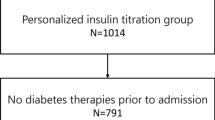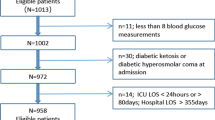Abstract
Objective
To find out if there is an association between hyperglycaemia and mortality in mixed ICU patients.
Design and setting
Retrospective cohort study over a 2-year period at the medical ICU of a university hospital.
Measurements
Admission glucose, maximum and mean glucose, length of stay, mortality, insulin therapy and Apache-II score.
Results
In 1085 consecutive patients, ICU- and hospital mortality were 20 and 25%, respectively. The total number of blood glucose measurements was 10.012. Admission glucose was 7.9 ± 4.5 mmol/l (mean ± SD), mean glucose 7.5 ± 2.9 and maximum glucose 10.0 ± 5.4 mmol/l. Median ICU length of stay (LOS) was 3.0 days (range 2.0–6.0 days, IQR), and hospital LOS was 16 days (range 7–32 days). In 28% of patients insulin treatment was started. Median Apache-II score was 13. 68% of patients were mechanically ventilated. Univariate analysis showed an association with ICU mortality for mean glucose (non-survivors 8.6 ± 4.3 vs 7.2 ± 2.4 survivors), maximum glucose (11.7 ± 5.9 vs 9.6 ± 5.2, non-survivors vs survivors, respectively), use of insulin (mortality 29 vs 17% in patients not using insulin) and age (61 vs 55.7 years). Gender and a history of diabetes mellitus were not associated with mortality. In a multivariate model, the Apache-II score was the only variable associated with mortality independent of other variables, including mean blood glucose.
Conclusion
In this retrospective study mean glucose level was not an independent risk factor for mortality in mixed ICU patients.
Similar content being viewed by others
Avoid common mistakes on your manuscript.
Introduction
Hyperglycaemia frequently occurs in ICU patients. Van Den Berghe et al. demonstrated that normoglycaemia decreased mortality considerably in cardiothoracic patients [1]. These patients were less ill than our mixed ICU patients (median Apache II score 9 vs 13 in our ICU). Whether strict glucose regulation is also advantageous in mixed ICU patients has not yet been proven [2]. We evaluated glucose levels at our ICU over a 2-year period, firstly, to obtain an overview of glucose regulation and, secondly, to investigate whether there exists a correlation between glucose levels and mortality. Our ICU is a university-based, 12-bed, closed-format medical ICU with an “overflow” function for surgical (and neurosurgical) patients.
Methods
Data of all patients admitted from September 2000 to September 2002 were collected from the hospital information system. Patients admitted for short elective diagnostic procedures were excluded (n = 173). Data on ICU- and hospital mortality, admission-, maximum and mean blood glucose, ICU and hospital length of stay (LOS), insulin therapy at the ICU, Apache-II score, gender, age, prior history of diabetes, mechanical ventilation and diagnosis were collected. Arterial blood glucose levels were determined at the clinical laboratory (Yellow Springs Instruments, Yellow Springs, Ohio). The local medical ethics committee agreed with the design of our study.
Intravenous insulin (Velosuline, Novo Nordisk, Kopenhagen, Denmark) was started if glucose level was above 10–12 mmol/l using a “dynamic scale” protocol which had no specific glucose target at that time; arterial blood glucose was determined every 4–6 h. Enteral feeding was initiated as soon as possible (generally within 24 h after admission, if needed, via a duodenal sonde). Baseline and outcome variables were compared with the χ2 test, the t-test for independent samples or the Mann–Whitney U test, as appropriate. Risk factors that were statistically significant in the univariate analysis were entered in multiple logistic regression analyses. In this model, interaction between mean and maximum glucose and mortality was studied. Apache scores were included as ≤ 9 or ≥ 9, like Van Den Berghe et al. did [1]. Since we calculate Apache scores during a 3-month period every year during our ongoing quality project performed by a specialized research nurse, we have Apache data for one-quarter of study patients. Data were expressed as mean ± SD (or median, IQR). The SSPS version 12.0 (SAS Institute, Chicago, Ill.) was used.
Results
Patient characteristics
A total of 1085 patients were included: 56% male, age 57 ± 18 years. The ICU LOS was 3.0 days (range 2.0–6.0 days; median, IQR); hospital LOS was 16 days (range 7–32 days; median, IQR). A history of diabetes mellitus was present in 17% of cases (2% type 1, 15% type 2). Apache-II score (calculated for 238 patients) had a mean of 14, median 13 (range 7–19, IQR). 68% of patients were mechanically ventilated. Admission diagnoses are depicted in Table 1.
Glucose values
The number of glucose measurements was 10,012. Admission glucose (mean ± SD) was 7.9 ± 4.5 mmol/l, maximum glucose 10.0 ± 5.4 mmol/l and mean glucose during ICU admission 7.5 ± 2.9 mmol/l. In 303 (28%) patients insulin was administered. The ICU mortality was 20%, and hospital mortality rate was 25%.
Variables associated with mortality
The univariate analysis associated with ICU mortality was as follows (Table 2):
-
1.
Mean glucose: non-survivors 8.6 ± 4.3 vs 7.2 ± 2.4 mmol/l in survivors
-
2.
Maximum glucose: non-survivors 11.7 ± 5.9 vs 9.6 ± 5.2 mmol/l in survivors
-
3.
Administration of insulin during ICU admission: 29% of patients with insulin died vs 17% of patients without insulin
-
4.
Age: non-survivors had a mean age of 61.0 vs 55.7 years in survivors.
The variables gender (p = 0.19, χ2-test) and history of diabetes mellitus (both type 1 and type 2; p = 0.11, χ2-test) were not associated with mortality. Apache-II score was available for 238 patients. Of the patients, 33% with a score ≥ 9 died, vs 5% with a score ≤ 9 (p < 0.0001, χ2-test).
With the Apache score included in a multivariate model, it appeared to be the only variable associated with mortality independent of the other variables (odds ratio 10.4). An increase of mean glucose was therefore not associated with mortality independent of other variables, including the Apache score.
In this model, the Apache scores were included as ≤ 9 or ≥ 9. In the Van den Berghe et al. paper [1] Apache scores were dichotomized this way, since the median score in their study was 9. In our study the median Apache score was 13. When the same multivariate model was run with Apache scores divided into lower or higher than 13, this did not change outcomes substantially.
Discussion
We expected a higher mean glucose level during ICU admission to be associated with increased mortality. This was based on a literature review we performed on the effects of hyperglycaemia during stress and on the outcomes of the Van den Berghe study [1]. In the univariate analysis, mean glucose, maximum glucose, use of insulin and age were associated with ICU mortality; however, mean glucose did not appear to be an independent predictor of mortality in the multivariate analysis. The only independent variable predicting mortality was the Apache-II score. In other words, patients who die have a higher mean glucose, but this seems only to reflect the severity of disease as expressed by the Apache-II score.
The limitations of our study are, of course, acknowledged. The retrospective design precludes concluding whether use of insulin during ICU admission increases mortality: Is it the insulin or were these patients simply more severely ill [3]? Van Den Berghe et al. found that both the mean daily amount of infused insulin and the mean glucose level during ICU stay were independent positive risk factors for ICU mortality [4]. The relation between higher Apache-II scores and mortality has uniformly been established. In a recent retrospective study in >1800 heterogeneous ICU patients both Apache-II scores and increasing mean glucose values were independent predictors of hospital mortality in a heterogeneous ICU population [5]. In that study mean glucose value was higher ( ± 8.6 mmol/l for the whole group) than in our study. In 97 surgical and 38 medical ICU patients, Christiansen et al. suggest that hyperglycaemia is a marker of increased morbidity and mortality in surgical, but not in medical, patients [6]. The number of medical ICU patients in this study is, in our opinion, insufficient to draw a firm conclusion. In a retrospective study in 2713 medical, surgical, neurosurgical and cardiothoracic ICU patients, higher mortality was found in hyperglycaemic patients in the cardiothoracic, cardiac and neurosurgical units, but not in the medical and surgical ICU [7].
Mean glucose level during the study period (September 2000 to September 2002) appeared to be 7.5 mmol/l, which seems fairly good. It is considerably lower than in the recently published prospective study by Krinsley, in which the control group had a mean glucose level of 8.4 mmol/l [8] and also lower than the conventional treatment group in the Van Den Berghe et al. study: 8.5 mmol/l [1]. The question arises, therefore, as to whether implementing a strict glucose-regulation protocol in our medical ICU would result in equal impressive effects on mortality and morbidity. On the other hand, since our ICU mortality is 20%, which is higher than in the thoracosurgical population of the Van Den Berghe [1] study (8%), less definite effects on glucose levels could still result in a considerable effect on mortality.
Conclusion
In conclusion, mean glucose level was not a risk factor for mortality in mixed ICU patients independent of, among others, the Apache score. This does not contradict the results found by Van Den Berghe [1], which show the effect of an intervention, namely, intensive insulin therapy, in critically ill patients. The role of intensive insulin therapy at medical intensive care units should be studied in a prospective, randomized and controlled study design.
References
van den Berghe G, Wouters P, Weekers F, Verwaest C, Bruyninckx F, Schetz M, Vlasselaers D, Ferdinande P, Lauwers P, Bouillon R (2001) Intensive insulin therapy in the critically ill patients. N Engl J Med 345:1359–1367
van der Horst IC, Gans RO, Nijsten MW, Ligtenberg JJ (2003) Beneficial effect of glucose-insulin-potassium infusion in noncritically ill patients has to be proven. J Intern Med 254:513
van der Horst IC, Gans RO, Zijlstra F, Ligtenberg JJ (2004) Exogenous insulin and hypoglycemia as prognostic factors in critically ill patients. J Am Med Assoc 291:558–559
van den Berghe G, Wouters PJ, Bouillon R, Weekers F, Verwaest C, Schetz M, Vlasselaers D, Ferdinande P, Lauwers P (2003) Outcome benefit of intensive insulin therapy in the critically ill: insulin dose versus glycemic control. Crit Care Med 31:359–366
Krinsley JS (2003) Association between hyperglycemia and increased hospital mortality in a heterogeneous population of critically ill patients. Mayo Clin Proc 78:1471–1478
Christiansen C, Toft P, Jorgensen HS, Andersen SK, Tonnesen E (2004) Hyperglycaemia and mortality in critically ill patients. A prospective study. Intensive Care Med 30:1685–1688
Whitcomb BW, Pradhan EK, Pittas AG, Roghmann MC, Perencevich EN (2005) Impact of admission hyperglycemia on hospital mortality in various intensive care unit populations. Crit Care Med 33:2772–2777
Krinsley JS (2004) Effect of an intensive glucose management protocol on the mortality of critically ill adult patients. Mayo Clin Proc 79:992–1000
Acknowledgements
We thank P. Dijkstra for expert statistical advice, M. van der Tuuk for providing us with data from the hospital information system and the ICU nursing staff for their cooperation.
Author information
Authors and Affiliations
Corresponding author
Rights and permissions
About this article
Cite this article
Ligtenberg, J.J.M., Meijering, S., Stienstra, Y. et al. Mean glucose level is not an independent risk factor for mortality in mixed ICU patients. Intensive Care Med 32, 435–438 (2006). https://doi.org/10.1007/s00134-005-0052-y
Received:
Accepted:
Published:
Issue Date:
DOI: https://doi.org/10.1007/s00134-005-0052-y




